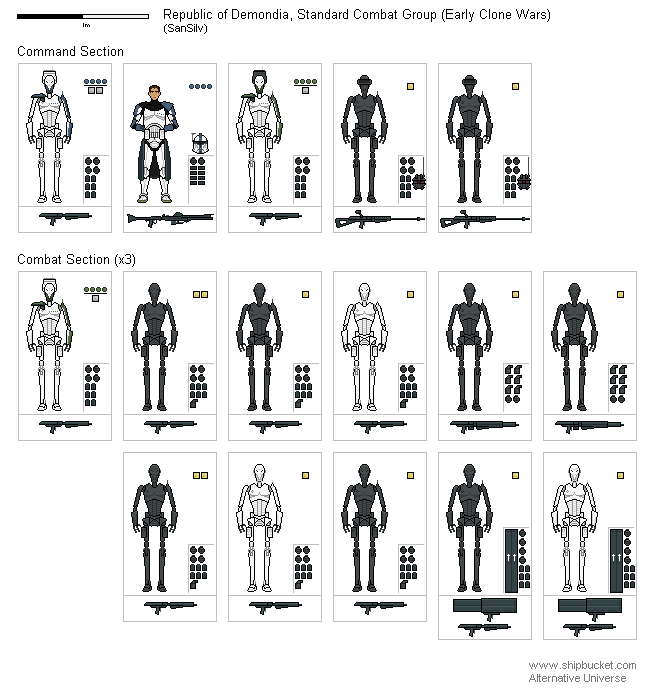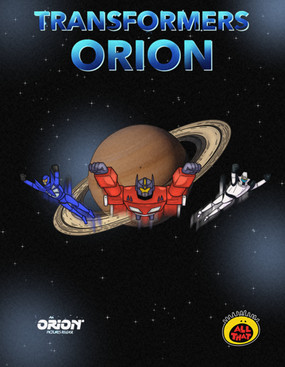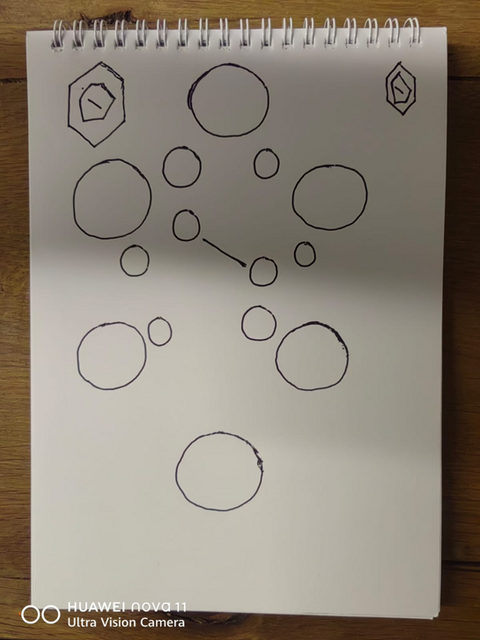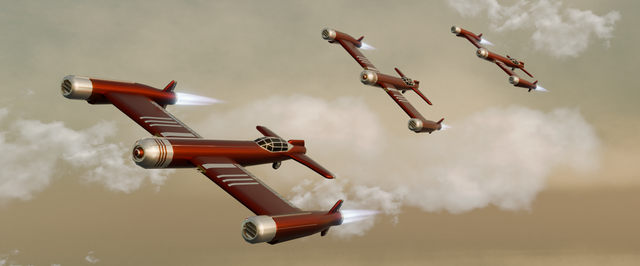HOME | DD
 Joshua15543 — Demondian Platoon
Joshua15543 — Demondian Platoon

#au #infantry #military #platoon #starwars #headcannon #clonetrooper #droids #starwarsclonewars
Published: 2021-11-23 13:57:40 +0000 UTC; Views: 4456; Favourites: 26; Downloads: 13
Redirect to original
Description
In 49 BBY, the Trade Federation of Planets and the Republic of Demondia had come to a series of lucrative trade deals, giving the Trade Federation a near total-monopoly on the sale of rare strategic resources mined by the Republic on its various worlds. In exchange for these deals, the Trade Federation gave the plans for its OOM security droids to the Republic, who began a program to replace its human-manned army with a droid one, citing the unethical nature of the draft that was in place at the time which forcibly conscripted males aged 17 to 45 for military service.Development on a copy of the OOM droids was undertaken by DroTec and would take years for functional models to be produced. DroTec identified a number of faults and deficiencies in the OOM design, both in hardware and software, and went through an extensive remodeling process of the two. After so long however, all existing OOM software was thrown out and a new framework was made. The new framework would be configured just for combat, as policing and non-military security duties were still to be conducted by the Republican Police Force, which meant it would still be done by humans. Over time, a servile protocol for maintenance on various ships, vehicles and other army equipment would be created as well.
By 45 BBY, DroTec would unveil its new droid, known as the MPD-332 in the Republican Army. The MPD-332 could be called an inbetween of the OOM and later B1 battle droids, and of the B2 super battle droids. It was more capable and less prone to AI malfunctions than the B1, as well as more resistant to blaster fire, explosions, and general wear and tear, however it was more expensive to produce than the standard B1. Clone Troopers of the Grand Army of the Republic were known to call them B1.5s at times due to their nature.
Production would be rapid, as DroTec switched production from commercial protocol droids to filling the massive military order that came in. During the Clone Wars, when production would be ramped up, other, more minor droid manufacturers such as Auto-Weld Industries and Globus Engineering would be contracted to produce the MPD-332 as well.
Standard equipment for the MPD-332 would be magazine pouches, a thermal detonator container and optional gear such as a macrobinocular device that could be fitted much in the same way similar devices could be fitted on the later Republic Clone Trooper helmets.
Weaponry would be provided by the state-owned Republic Ordinance Armories. The mainline blaster would be the BL-33D, a modification to the previous issue blaster, with the D denoting its use for droids. The BL-33 would see much of the safety features to protect humans being removed, as well as a new trigger assembly to work better with the hands of the MPD-332. Comparable to most other blasters in service, it did not have a selectable power setting and no stun feature, as this was an army only weapon, and civilian pacification would in theory be taken care of by detachments from the RPF. The BL-33’s power cell is good for 50 shots. The trigger is capable of semi and repeating fire. Pulling the top of the trigger engages the semi-automatic fire, while pulling the bottom engages the repeating mode. This works with the two “fingers” of the MPD-332. The rate of fire is roughly 800 shots per minute.
The BL-33D was designed to be a modular system, and spawned two major variants that would see service with the droid army of the Republic. The BL-33DS and HBL-33D were built off the BL-33D, but with a reinforced receiver to take both longer and more powerful firing. The BL-33S is the standard sniper rifle model. Fitted with a stock from the human-use BL-33 and a longer barrel the rifle is very accurate compared to the standard BL-33D. It also has a much more powerful firing system, which does reduce the effective shots per power cell. A standard power cell when used in a BL-33DS will only produce 10 shots instead of 50. The sniper rifle also features a macrobinocular optic allowing an operator to get distance and altitude of whatever the optic was placed over.
The HBL-33D was the standard heavy repeating blaster model, roughly analogous to the T-21 or DLT-19 repeating blasters. Fitted with an extensive cooling system and longer barrel to allow for more accurate firing during prolonged bursts, it also was commonly issued with expanded power cells that allowed for 150 shots. The expanded power cell could be used in regular BL-33 series blasters, and the standard 50-round power cell can be used in the HBL-33D, allowing for ease of logistics and the ability to keep firing in the event that the heavy gunners expend all their ammunition in combat.
Along with blasters, a new projectile launcher would also be adapted from human-use to droid use. This would be the SPL-7. Firing anti-armor missiles, concussion missiles or even proton torpedoes, the launcher featured a quad-barrel and loaded missiles in four missile “cartridges” of sorts. The trigger is adopted from the BL-33D, but only produces one launch per trigger pull. A guidance device can be fitted for the use of guided missiles.
Thermal detonators, designated TND-19 were retained from the human army. The fuse has an adjustable timer or can be set to impact. The effective range of the blast is six meters with an MPD-332 being able to throw a TND-19 over 30 meters.
---
By 39 BBY, the Republican Army had transitioned almost entirely to droids, with the only humans being high-ranking officers, high competence maintenance personnel, and special forces. The close relationship between the Trade Federation and the Republic would begin to erode following the Invasion of Naboo, the ensuing Trade Wars, and the Eriadu Trade Summit all happening in 32 BBY. This saw the worryingly rapid militarization of the Trade Federation which itself was coming with an overall worsening of the Galactic situation. While not an ally of the Galactic Republic in any sense, if anything being opposed to them, this drew the Republic of Demondia closer to them.
This would come to a head in 30 BBY when a Trade Federation fleet consisting of a single Lucrehulk-class and some Captor-class heavy cruisers attempted to blockade Cellus, in an attempt to force the Republic of Demondia to renegotiate the old trade agreements. The Republic deployed much of its navy, which consisted mainly of Dreadnaught-class cruisers, CR90-class corvettes and DP20-class frigates. The ensuing space battle would end in a Republic victory, but at the expense of a huge portion of its fleet. This ended all friendly relations with the Trade Federation and would see to the Republic’s own militarization and expansion in preparation for the coming galaxy wide conflict.
The preparation would come to pay off in 27 BBY when the Republic and the newly formed Confederation of Independent Systems would go to war. The Demondian Republic would throw its hat in with the Galatic Republic, citing years of provocation and warlike behavior by the now-members of the newly formed CIS.
The first engagements would find the Demondian Republic in fierce defensive battles on planets in the Outer Rim. Lacking in numbers as the GAR focused its attention north, the Demondians along with various planetary and sector defense forces began to conduct fighting withdrawals from many planets. The Demondian droids made a name for themselves as an effective and capable force, able to conduct offensive operations even in the face of the generally overwhelming droid armies of the CIS. Their effectiveness however was marked by a general disregard of the droids, with friendly fire, and “friendly fire” incidents being common. Very early on, the previously dark gray painted droids were being replaced by white-painted droids. Being painted dark gray, they were commonly mistaken for super battle droids or for commando droids. Priority was not put on repainting all droids, so instead replacement would be done via attrition, as replacement droids would arrive, they would slowly replace the older, gray-painted ones.
This is the time period from which the platoon is depicted. The mixture of gray and white droids along with gray and white equipment, such as the macrobinocular devices on the various droids. Along with this, the white painted droids in command positions also gear ranking marks from the GAR. This was to allow for rapid identification by various Republic forces, as the Demondians themselves did not put rankings on them but did assign them ranks according to what their function was in the platoon.
The platoon is of a mostly conventional layout, consistanting of a platoon leader, whose main role is to coordinate the movement and position of the platoon to the company commander. Orders from higher commanders are transmitted from the platoon leader to the platoon sergeant. A Grand Army of the Republic liaison clone lieutenant in their early Phase 1 armor and with their own DC-15A blaster rifle. The liaison officer acts as an intermediary between clone units and the droid unit he is attached to. It is a position few clones wish to be in, as working with “clankers” even if allied to them, is considered to be very demeaning. A platoon sergeant to command the sections themselves and to interpret orders from the platoon commander. Also two scout units are located in the command section, armed with their sniper rifles, they form a lead element in scouting ahead of the platoon and feed information to them via their scout droid or directly via their macrobinoculars. They are equipped with the ASD-11, a scout droid that can relay information to the scouts and the command element.
From there there are three combat sections per platoon. Commanded by a sergeant they are organized into two teams of five, a “Gun Team” and a “Rocket Team”. The gun team is tasked with establishing fire superiority with their heavy blasters and assistants. While the rocket team is tasked with hard target and anti-tank work. The teams are commanded by Team Leaders who follow the squad leaders orders and organize and lead their fellow droids.
The droids are able to transmit and execute orders between them without any need for audible speaking. This allows the droids to act with minimal sound, only producing sound when moving rapidly and firing. Clone troopers and other regional defense troopers find this unsettling at times, as the droids do not normally communicate their operations to their allies unless there is an operational need for it.
Standard ammo allotment is six power cells plus the one loaded in the blaster. Additionally, extra expanded power cells are issued out to provide spare ammo to the heavy blasters. Additional equipment is made available as needed. Heavy vehicles and transport vary, and the droids are able to collapse down to a much smaller size for compact storage.
























